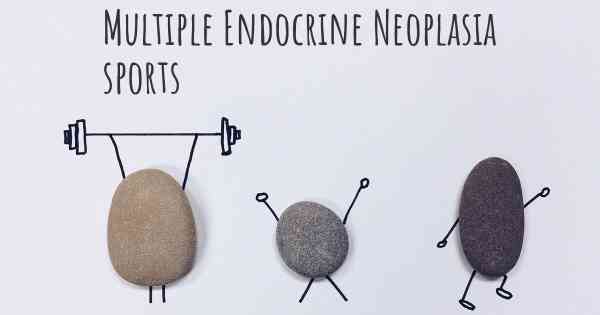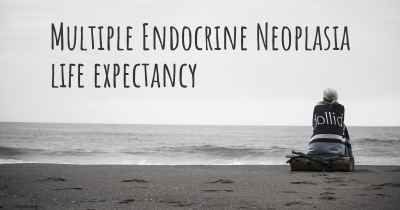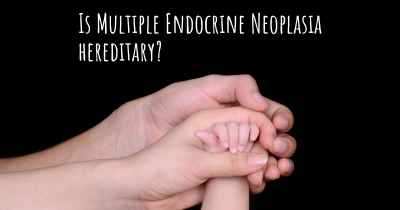Is it advisable to do exercise when affected by Multiple Endocrine Neoplasia? Which activities would you suggest and how intense should they be?
See if it is advisable for people with Multiple Endocrine Neoplasia to practice sports and which ones are the most recommended if you have Multiple Endocrine Neoplasia

Exercise and Multiple Endocrine Neoplasia (MEN)
Multiple Endocrine Neoplasia (MEN) is a rare genetic disorder that affects the endocrine system, leading to the development of tumors in various glands. There are different types of MEN, including MEN1, MEN2A, and MEN2B, each with its own specific characteristics and associated risks.
When it comes to exercise and MEN, it is important to consider the individual's specific condition, overall health, and the advice of their healthcare team. While exercise can have numerous benefits for most individuals, including improved cardiovascular health, increased strength, and enhanced mental well-being, it is crucial to approach exercise with caution in the case of MEN.
Benefits of Exercise for Individuals with MEN
Engaging in regular exercise can have several potential benefits for individuals affected by MEN. These benefits may include:
- Improved cardiovascular health: Exercise can help strengthen the heart and improve blood circulation, reducing the risk of cardiovascular complications that may arise from MEN.
- Enhanced bone health: Certain types of MEN, such as MEN1, can increase the risk of osteoporosis. Weight-bearing exercises, such as walking or resistance training, can help improve bone density and reduce the risk of fractures.
- Weight management: Maintaining a healthy weight is important for overall well-being and can help manage certain symptoms associated with MEN, such as insulin resistance or hormone imbalances.
- Stress reduction: Regular physical activity can help reduce stress levels and improve mental well-being, which can be particularly beneficial for individuals dealing with the challenges of living with MEN.
Exercise Recommendations for Individuals with MEN
It is crucial for individuals with MEN to consult with their healthcare team before starting or modifying an exercise routine. The recommendations may vary depending on the specific MEN type, the presence of any associated conditions, and the individual's overall health status. However, here are some general guidelines that may be considered:
- Low-impact aerobic exercises: Activities such as walking, swimming, or cycling can be beneficial for cardiovascular health without putting excessive stress on the joints.
- Strength training: Incorporating resistance exercises, using bodyweight or weights, can help improve muscle strength and bone density. However, it is important to use proper form and start with light weights, gradually increasing intensity under the guidance of a qualified professional.
- Flexibility exercises: Stretching exercises, yoga, or Pilates can help improve flexibility, posture, and overall body awareness.
- Balance and coordination exercises: MEN2B, in particular, may be associated with balance and coordination issues. Engaging in activities such as tai chi or specific balance exercises can help improve stability and reduce the risk of falls.
Exercise Intensity and Safety Precautions
The intensity of exercise should be determined on an individual basis, considering factors such as overall fitness level, MEN type, associated conditions, and any specific limitations or precautions advised by the healthcare team. It is important to start slowly and gradually increase the intensity and duration of exercise sessions.
Some general safety precautions to consider when exercising with MEN include:
- Regularly monitoring blood pressure and heart rate during exercise, especially for individuals with cardiovascular involvement.
- Being aware of any signs or symptoms of fatigue, dizziness, or shortness of breath, and adjusting the intensity or duration of exercise accordingly.
- Using proper equipment and techniques to minimize the risk of injury, especially during strength training exercises.
- Staying hydrated and taking appropriate breaks during exercise sessions.
- Listening to the body and not pushing beyond personal limits, especially if experiencing pain or discomfort.
Conclusion
While exercise can have numerous benefits for individuals affected by Multiple Endocrine Neoplasia, it is crucial to approach it with caution and under the guidance of a healthcare team. The specific exercise recommendations and intensity should be tailored to the individual's condition, overall health, and any associated risks. Regular communication with healthcare professionals is essential to ensure a safe and effective exercise routine that supports overall well-being.
Posted Oct 25, 2017 by Mrcperk 2000
Posted Sep 3, 2019 by Crystal 1750








